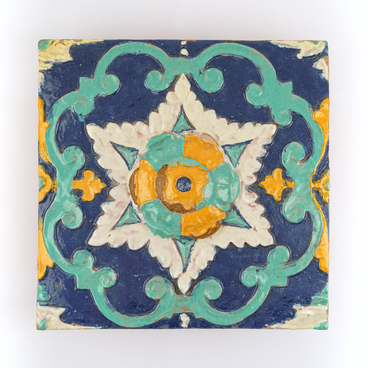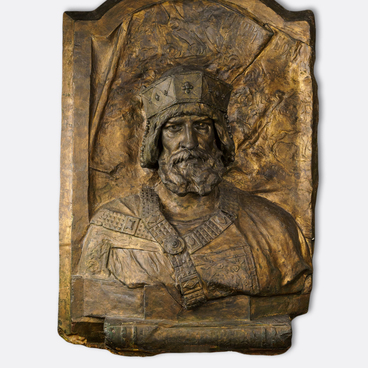The museum’s exhibition presents a square-shaped polychrome relief tile. It is a modern replica, stylized as a product of the 17th–18th centuries. The glazed tile is decorated with a convex stylized vegetal pattern depicting a bird in the center. The “rumpa” box-shaped compartment on the reverse side has round holes on the edges.
The exhibit is created by Alexey Yegorov, an outstanding Yaroslavl ceramist and restorer, Honored Art Worker of the RSFSR, born in 1931. Yegorov is known first of all for making tiles to restore the ornamental decoration of Yaroslavl churches of the 17th century: St. Michael the Archangel, the Epiphany, St. John the Baptist and a number of others. He worked not only in Yaroslavl, but also in Moscow, Samara, Nizhny Novgorod, Minsk, as well as in cities of Central Asia and other regions. As an artist, craftsman and technologist, he discovered many lost secrets of tile making.
Glazed tiles consist of two elements: the outer tile and a box-shaped compartment on the back to fix it to the masonry. “Carved bricks” began to be used in Russia in the late 15th century. They were terracotta slabs — precursors of tiles. They were made like gingerbread: clay was shaped in wooden carved molds and then fired in ovens. In the 16th century, relief slabs began to be combined with rumpa compartments raised on a potter’s wheel, and thus tiles were made. Terracotta products were called “red” — by the color of the fired clay. There were square tiles of “big hand” (20 by 20 centimeters) and “small hand” (14 by 14 centimeters).
The golden age of Russian tiles was the 17th century. Craftsmen started to produce glazed tiles with a coating on the top. Tiles in the form of plates and columns came into use. At first the reliefs were covered with transparent glaze — murava. Most often the color “trava-murava” (grass) was used, and “muravlennye” tiles became a synonym for “green”. Later, they began to decorate the products with opaque tin glaze of different colors — tsenina (majolica). That is why polychrome tiles were called tzenin tiles, and tile art was referred to as “tsenin work”.
Original tiles were produced in Moscow, Veliky Ustyug, Vologda, Kaluga, Balakhna
and other places. The most famous workshop of the 17th century existed at
Patriarch Nikon’s New Jerusalem Monastery. Stepan Polubes, who created the
popular “peacock eye” pattern, worked there.



